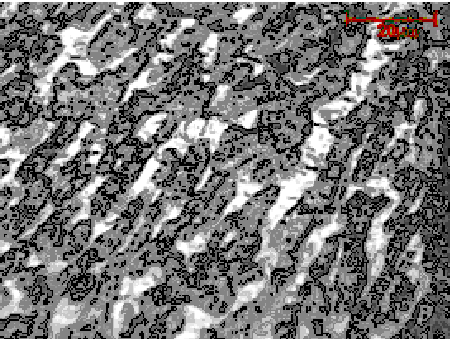
|
|
|
|
[Contents] | [Index] |
Cooperation with: W.H. Müller (Technische Universität Berlin)
Description:
The reliability of solder joints plays a crucial role in the microelectronic packaging industry. In a real-life situation these solders, such as eutectic SnPb alloy, that consist of a fine mix of tin and lead, begin to form regions of high lead and tin concentration, see Figure 1. This coarsening process which is initiated by diffusion and enforced by the effects of surface tension as well as the exposure to thermo-mechanical stresses, has a drastic influence on the material properties of the solder.
We have investigated here specifically the influence of anisotropic surface tension on the shape of the precipitates formed in this process. For this purpose we derived in [4], on the basis of matched asymptotic analysis, a Sharp Interface Model (SIM) for the two-dimensional phase-field model for SnPb eutectic alloy, as developed and investigated by [1], [2] and [3].
The SIM considers the situation when the solution of the corresponding
phase-field model has reached phase equilibrium and focuses on the slow
(time scale
![]() ) evolution of the lead precipitates in a tin matrix.
The resulting SIM is solved using a boundary integral method.
In this setting
it is also possible to derive the exact stationary solutions attained and
to determine the dependence of their shape on anisotropy and mass. A linear
stability analysis showed that, as in the isotropic case, the stationary
solutions are stable.
) evolution of the lead precipitates in a tin matrix.
The resulting SIM is solved using a boundary integral method.
In this setting
it is also possible to derive the exact stationary solutions attained and
to determine the dependence of their shape on anisotropy and mass. A linear
stability analysis showed that, as in the isotropic case, the stationary
solutions are stable.
For the numerical method we used a pseudo-spectral method for the spatial discretization of the boundary integral formulation for the precipitate-matrix interfaces. The parametrization of the boundary integral formulation is chosen such that it allows to isolate the stiffest terms in the evolution equation, which has to be treated implicitly, while the rest is updated explicitly.
Numerical simulations show strong dependence of the inter-precipitate mass flow on the shape of the precipitates.
![\makeatletter
\@ZweiProjektbilderNocap[h]{0.48\linewidth}{e-side-by-side.eps}{e-top-and-bottom.eps}
\makeatother](img545.gif)
|
In Figure 2 we start in both cases with precipitates which are stationary solutions by themselves. In both cases the closest distance to each other is the same. We observe that not high curvature but the length of the interfaces with smallest distance plays the dominant role for mass flux, see Figure 3. Moreover, interestingly, the shapes of the precipitates approach the form of elongated lamellae when they gain mass, while they become more circular when they loose mass.
We include the effects of the stress and strain and study their influence on the stability of our solutions.
References:
|
|
|
[Contents] | [Index] |